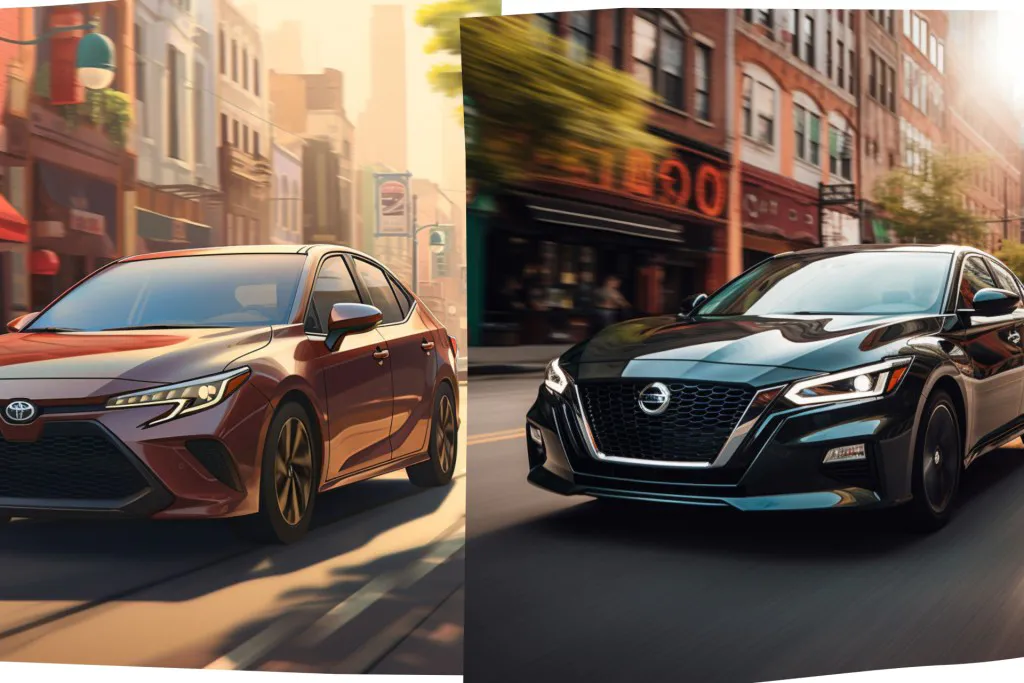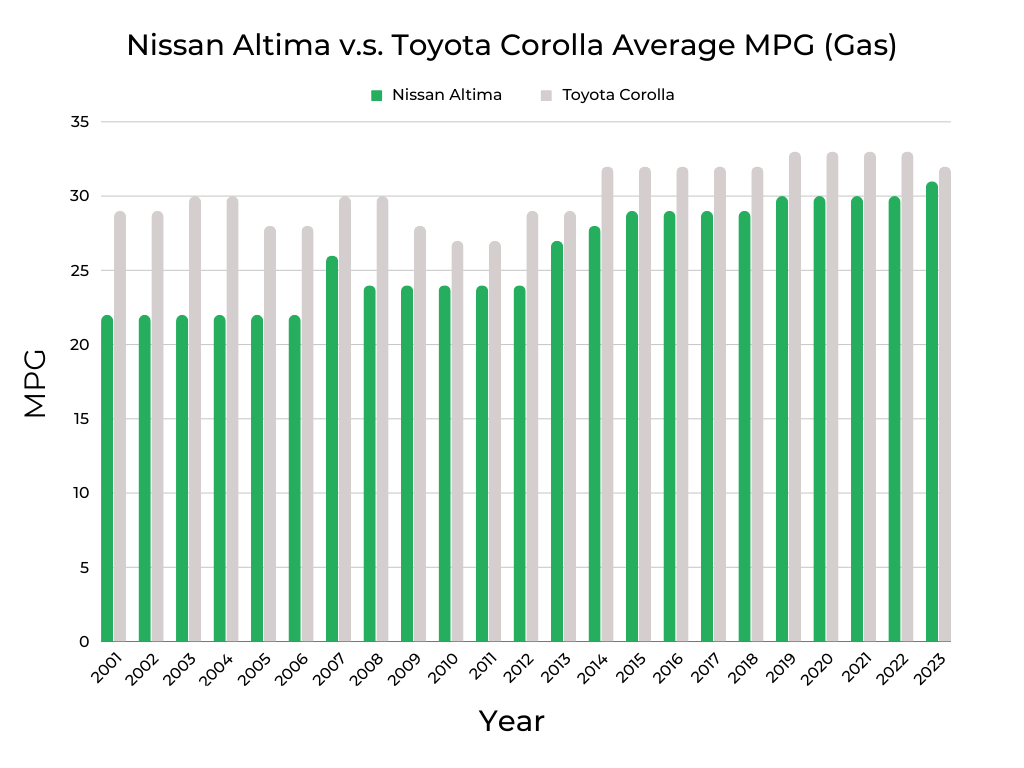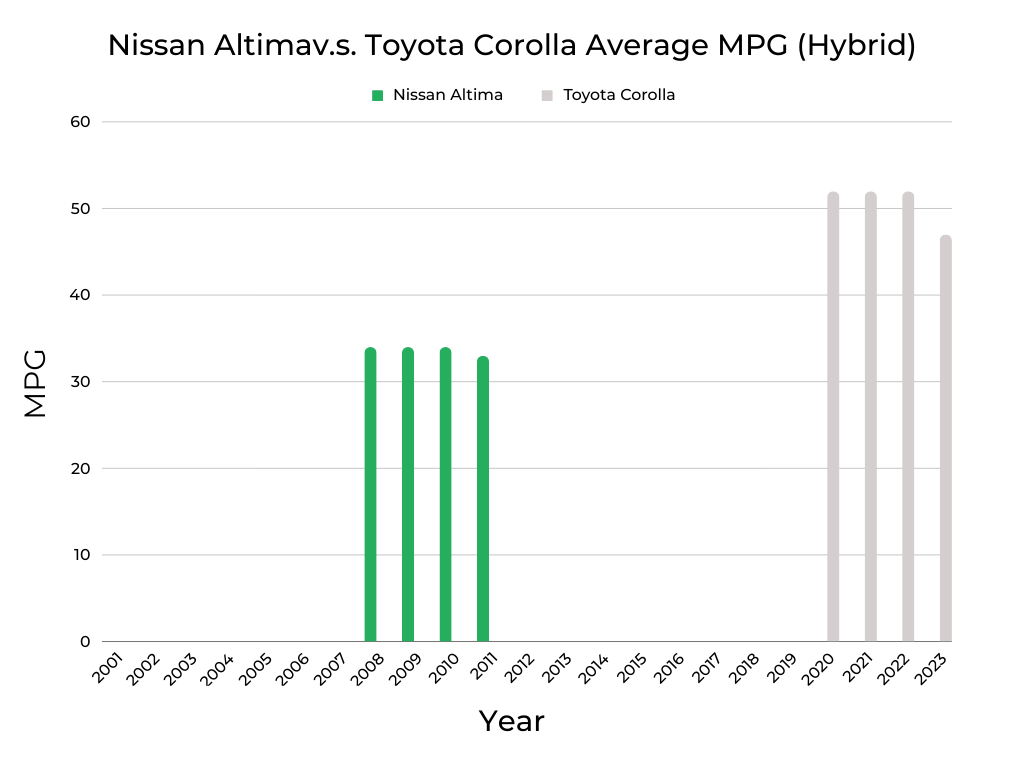While many car shoppers are concentrated on buying SUVs and pickups, the market for passenger cars remains vibrant. The Alliance for Automotive Innovation reports that sedans, hatchbacks, and wagons still account for 35% of new vehicle sales. Of these, the Nissan Altima and Toyota Corolla have been around for decades and continue to be on shopping lists.
Even though these two Japanese nameplates don’t quite align in the market segment (the Altima is a mid-tier vehicle while the Corolla is more of an economy car), they share many characteristics, including sound safety scores, notable fuel economy, and good engine reliability. Cross-shopping these sedans (there’s also a Corolla Hatchback) makes sense because it increases your buying options—the choice is a buyer’s friend. The trick is to wade through what’s for sale and narrow your focus. That’s what this article is all about.
Keep reading to learn vital details, whether you’re considering a new Altima or Corolla or have thoughts of something second-hand. Although I’ve had ownership experience with Nissan and Toyota products, I’ve never had an Altima or Corolla in my garage. However, thanks to rental cars and dealer loaners, I’ve had my share of behind-the-wheel time with these vehicles. So, I approach this comparison with a combination of newcomer’s eyes and some experience with these models.
Like most people, I presumed the Corolla to be invincible, a forever trouble-free automobile. However, data from FIXD sensors and FIXD owner surveys uncovered insights that put a few holes in the Corolla’s armor. Chiefly, engine reliability and higher upkeep costs are issues with specific model years. Conversely, the Altima comes across in a better light after looking at its details. Compared to the Corolla, there are fewer Altima model years with mediocre or worse engine reliability. Maintenance and repair costs were less problematic.
From a new car perspective, the Altima costs more than the Corolla. That’s restating the obvious, but what’s not so evident is that the difference separating the two cars is as little as $2,000. That’s not a huge amount for cars selling below $30,000.
Dive in to learn more about this Nissan Altima and Toyota Corolla match-up. Other comparisons include Accord vs. Corolla, Accord vs. Civic, Outback vs. Forester, RAV4 vs. CR-V, Civic vs. Corolla, Pilot vs. Highlander, and Odyssey vs. Sienna.
| Income Bracket | Monthly Financing Cost Range | Cash Purchase Price Range | Nissan Altima Years | Toyota Corolla Years | Best Model Year: | Why? |
| $5k-$10k | $83-$125 | $3,000-$4,500 | 2010 | N/A | 2010 Altima | Above-average engine reliability, solid safety scores |
| $10k-$15k | $125 – $187 | $4,500-$6,750 | 2012 | 2010 | 2010 Corolla | Above-average engine reliability, low upkeep costs |
| $15k-$25k | $187 – $312 | $6,750-$11,250 | 2013 | 2013 | 2013 Altima | Very good engine reliability, low price, top safety scores |
| $25k-$35k | $312 – $437 | $11,250-$15,750 | 2017 | 2017 | 2017 Corolla | Very good engine reliability, solid safety scores |
| $35k-$50k | $437 – $625 | $15,750-$22,500 | 2021 | 2021 | TIE | Excellent engine reliability, solid safety scores |
See the methodology for the table above.
Before you respond to the “For Sale” ad, check out this How to Buy a Used Car article for a step-by-step checklist.
Nissan Altima Vs. Toyota Corolla Price History Comparison | Nissan Altima Vs. Toyota Corolla
Average Market Value – Based on Owners’ Self-Reported Mileages | Nissan Altima Vs. Toyota Corolla

Arguably, price is the biggest determiner for a car shopper. So, understanding how this factor adds up for the Nissan Altima (green) and Toyota Corolla (gray) is essential. The graph reflects market values from Kelley Blue Book (KBB), which is based on private-party transactions. Expect dealer prices to be up 50%–100%. If that extra outlay doesn’t work with your budget, consider shopping for an older car or one with more miles.
Overall, these numbers are consistent with the idea that newer cars are worth more than older ones. There’s a steady increase in market value as the model years get more recent. However, a closer look uncovers an interesting twist: for many model years (2005-2019), the Corolla is worth more than the Altima.
This caught my eye because Altimas have a higher original price (MSRP) than the Corolla. The Altima sits higher up in Nissan’s model range than the Corolla’s place in Toyota’s lineup. Put another way, the Altima is priced more like a Toyota Camry, while the Corolla’s cost is similar to the Nissan Sentra.
What does this mean? The Altima has worse depreciation than the Corolla. This matters less among the oldest model years (2001-2004) when depreciation has mostly bottomed out. Meanwhile, the Altima has maintained a higher market value among more recent model years simply because depreciation hasn’t fully set in and the sticker price is higher.
Be sure to read our Best and Worst Years series of articles highlighting the Nissan Altima and Toyota Corolla winners and losers.
Depreciation vs. Maintenance Expenses
As mentioned in the previous section, depreciation erodes a car’s value, especially with a newer vehicle. In the first year, the loss value can reach 10%-15% but grows to 40%-50% after five years. Sure, there are exceptions, but these are rare or collectible vehicles that don’t usually wear a Nissan or Toyota badge.
Buying cars that have already suffered through the worst of depreciation is one approach to stretch your dollars. After about ten years, declining resale values become less of an issue, and opportunities for smart buys open up. However, selecting any “old” car can lead to trouble and less money in the bank. Ideally, you also want a vehicle with a history of reasonable repair and maintenance expenses.
The combination of low depreciation and upkeep costs leads to “sweet spots” highlighted by the black-outlined boxes in the above graphs. The Altima’s persistent drop in resale value means looking at examples from the 2007-2014 model years. At the same time, there are purchasing opportunities for the 2003-2012 Corolla.
The Toyota has a broader window, but the same formula puts more recent (2013-2014) Altimas in the target zone.
Later, I’ll examine what repair costs look like for the Altima and Corolla. Be sure to review these details for a better understanding of where these sweet spot recommendations come from.
But don’t assume every example within these ranges is a wise buy. Learn more by reviewing the best and worst years of the Nissan Altima and Toyota Corolla. There’s also an at–a–glance summary towards the end of this article.
Reliability Comparison | Nissan Altima Vs. Toyota Corolla
Two ratings are at the core of our look at the Nissan Altima and Toyota Corolla.
- The FIXD Reliability Score measures the number of check engine lights recorded for a particular model year by installed FIXD sensors. Think of it as an engine reliability score. While every check engine light doesn’t directly translate into reliability concerns (such as a dead battery or loose gas cap), these indicators still provide insight into a car’s dependability. This data is weighted by mileage.
- The second rating is the Owner Reliability Score. This is a subjective ranking of how surveyed owners feel about their respective vehicles’ dependability. Each owner estimates how capable their car is for trips of different lengths. A vehicle that can handle a cross-country adventure receives the highest score, while a car only suitable for a quick point A to point B trip gets the lowest score.
Both rankings are based on 1 being the lowest, 10 being the highest, and 5 being the average score.
We’ll also point out that both scores seldom align. The FIXD Reliability Score is determined by a definitive number, the frequency of check engine lights. On the other hand, the Owner Reliability Score is opinion-based. Owners tend to have pride in their automobiles, with higher ratings as a result. At a minimum, those with older vehicles are more accepting of check engine lights. For many, it’s the price of owning an aging car.
Toyota has sold over 50 million Corollas under the premise that they’re bulletproof. But these FIXD Reliability Scores show that this car is far from perfect. Seeing poor rankings for 20-year-old year cars is unsurprising. But it’s the mediocre grades for decade-old Corollas that are eye-opening.
This Toyota exceeds 6 (out of 10) for engine reliability for only 7 out of the 21 reviewed years; that’s a poor 33%. Meanwhile, the Altima achieves the same results (6 out of 10 or better) for an improved 10 years or about 48%.
Overall, the Altima comes out on top with fewer check engine lights for 12 of 21 years, compared to 6 years for the Corolla. There was a tie for 3 years.
Of course, not every check engine light (CEL) is serious. Minor problems like a loose gas cap or dying battery can generate an error code. However, seeing the differences in CEL frequency is quite revealing.
In particular, there’s a noticeable shift from the older years (2001-2007)—when the Corolla had better engine reliability—to 2008 and later when engine reliability tilted to the Nissan’s favor. This signals that if you must buy an older Altima or Corolla, the Toyota is the way to go.
Yet, CELs don’t discourage owners from thinking positively about their Altimas and Corollas. FIXD owner surveys show that the Altima ranked a 6 (out of 10) or better for 15 of the 21 surveyed years. The Corolla does even better, scoring a 6 or better for 16 years.
These results show that CELs aren’t a significant turn-off for Altima and Corolla owners.
Review the Best and Worst Years articles on the Nissan Altima and Toyota Corolla to learn more about these vehicles’ FIXD Reliability and Owner Reliability Scores.
Longevity Comparison | Nissan Altima Vs. Toyota Corolla
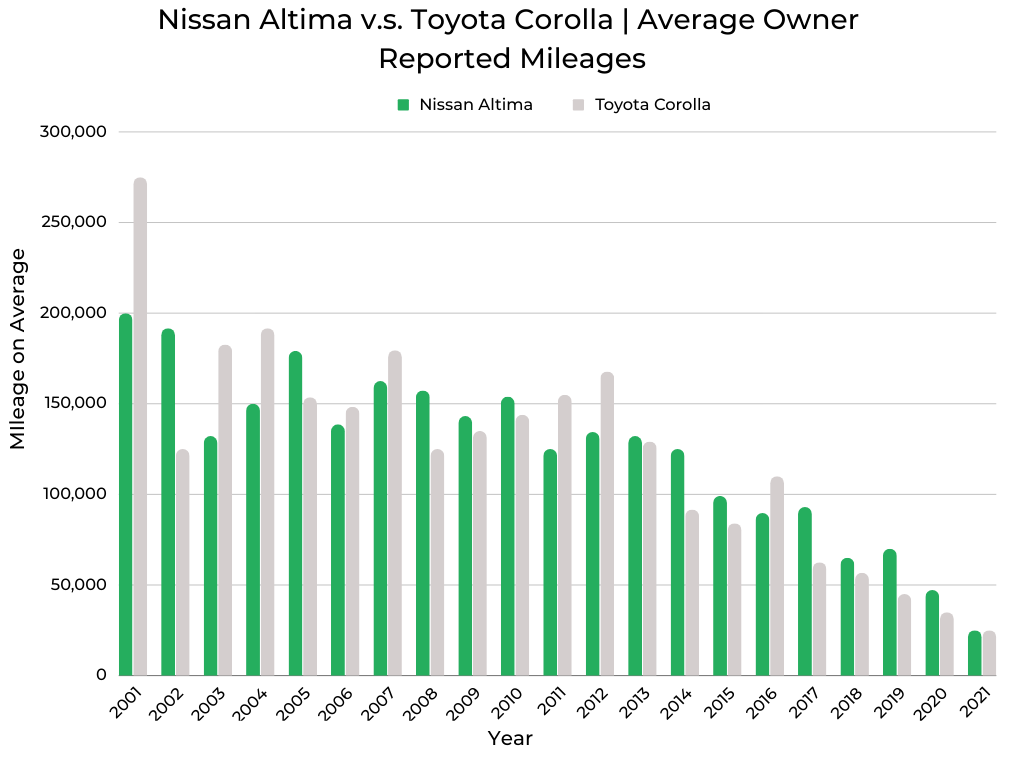 The graph for Altima and Corolla mileage history shows that both vehicles can reach or exceed the 150,000-mile benchmark, according to FIXD owner surveys. There are seven model years for both nameplates that can wear this badge of honor.
The graph for Altima and Corolla mileage history shows that both vehicles can reach or exceed the 150,000-mile benchmark, according to FIXD owner surveys. There are seven model years for both nameplates that can wear this badge of honor.
Things are equally divided when seeing which editions can hit the 200,000-mile mark. At the same time, it’s impossible to miss the notable achievement of the 2001 Corolla, which has 275,000 miles of use.
I also like to use for-sale listings to examine vehicle history because this information can provide a different snapshot. Based on autotrader.com offerings (November 27, 2023) for the 2001-2010 model years, 618 Altimas and 996 Corollas are for sale nationwide. Of these, 53 Altimas (8.6%) and 89 Corollas (8.9%) had at least 200,000 miles.
These startlingly similar results had me drill into the numbers further, looking for separation I didn’t find. Among these listings are 181 Altimas (29.3%) and 279 Corollas (28.0%) with 150,000-200,000 miles.
My conclusion is that there’s no clear longevity winner between the Nissan Altima and Toyota Corolla.
Review the individual articles on the best and worst years of the Nissan Altima and Toyota Corolla for a more thorough look at longevity.
2023 Nissan Altima Vs. Toyota Corolla | A Guide to Trim Levels & Optional Features
Trim Levels: Starting Prices
In the U.S., Nissan has positioned itself as a value player against its larger rivals (Toyota and Honda). Want a mid-sized sedan that’s often cheaper than a Camry or Accord? Head to the Nissan dealer for the Altima.
That said, a new Altima will cost more than a new Corolla as it’s more upmarket. Remember that these vehicles occupy different tiers in each manufacturer’s lineup. If you aim to buy something new and cheap, you’ll spend $21,700 for a Corolla LE. Doing the same for the Altima requires an extra $5,025.
Yet, the price gap narrows as you move up the respective model lineups. Going for something beyond a base edition means buying an Altima SV for $27,525 or a Corolla for $24,140, a $3,385 difference.
Going one step further can lead to a more challenging decision, as the Altima SR costs $28,925, and a Corolla XSE sells for $26,850. For an extra $2,075, you’ll get more power and space at the expense of lower fuel economy by going with the Nissan.
At this point, the trims take a very divergent path. The Altima SR VC-Turbo offers a more engaging driving experience (I’ll cover engine options later), while the Altima SL is a leather-trimmed variant with hints of luxury. Meanwhile, the Corolla offers hybrid versions and a hatchback body style.
While the wallet may ultimately drive the purchase decision between the Altima and Corolla, other factors (like equipment, body styles, and engines) may also come into play.
| 2023 Nissan Altima Model | Starting Price |
| S | $26,725 |
| SV | $27,525 |
| SR | $28,925 |
| SR VC-Turbo | $36,425 |
| SL | $33,425 |
| 2023 Toyota Corolla Model | Starting Price |
| LE | $21,700 |
| SE | $24,140 |
| XSE | $26,850 |
| Hybrid LE | $23,050 |
| Hybrid SE | $25,490 |
| Hybrid SE Infrared Edition | $26,025 |
| Hybrid XLE | $26,850 |
| SE Hatchback | $23,155 |
| XSE Hatchback | $26,580 |
2023 | Nissan Altima Vs. Toyota Corolla | Specifications | Safety, Interior, and Exterior Features
Sizing up the Nissan Altima and Toyota Corolla involves a look at each vehicle’s specifications. Here’s what you need to know.
Vehicle Class & Body Style:
Although the Altima and Corolla are categorized as mid-sized sedans by the U.S. Environmental Protection Agency (EPA), the interior room has a measurable difference. With 100.6 cubic feet of passenger volume, the Altima is more accommodating than the Corolla Sedan and its 88.6 cubic feet of passenger volume (the Corolla Hatchback is even smaller with 84.6 cubic feet). However, for those who like the five-door versatility of the Corolla Hatchback, the Altima’s four-door sedan configuration falls short.
Further along, I’ll compare the interior dimensions of the Altima and Corolla.
| 2023 Nissan Altima | 2023 Toyota Corolla | |
| Class | Mid-Size Sedan | Mid-Size Sedan /Hatchback |
| 4-Door Sedan | S, SV, SR, SR VC-Turbo, SL |
LE, SE, XSE, LE Hybrid, SE Hybrid, SE Infrared Edition Hybrid, XLE Hybrid |
| 5-Door Hatchback | N/A | SE Hatchback, XSE Hatchback |
Powertrain:
Engine Options & Specifications:
If four cylinders are your preferred engine configuration, then you’re in luck; that’s the only option for the Altima and the Corolla.
Nissan tucks a 188-horsepower 2.5-liter engine under the Altima’s hood for most trims. Its 0-60 mph time of 7.5 seconds isn’t breathtaking, but it should meet most people’s expectations, especially for highway on-ramps.
On the other hand, the Corolla’s standard engine is a 2.0-liter setup that makes 169 horsepower and completes a 0-60 run in 8.2 seconds. If you like your cars “zippy,” the Corolla may not be your best choice. The trade-off is that a base-engine Corolla gets 10%–15% better fuel economy.
If keeping gas station trips to a minimum is your priority, then it’s hard to argue against the Corolla Hybrid. The hybrid 138-horsepower 1.8-liter engine won’t win any acceleration races (its 0-60 time of 9.0 seconds is turtle-like), but up to 53 mpg is nothing short of impressive.
Nissan’s approach to an engine upgrade for the Altima is quite different. Its VC-Turbo engine uses variable compression technology to adjust cylinder function based on the need for power or efficiency. It’s sophisticated technology, unusual in a mainstream car like the Altima, but the results are apparent. The Altima SR VC-Turbo packs a decent punch with 248 horsepower and a smile-inducing 0-60 time of 6.4 seconds. No one will complain about fuel economy up to 34 mpg.
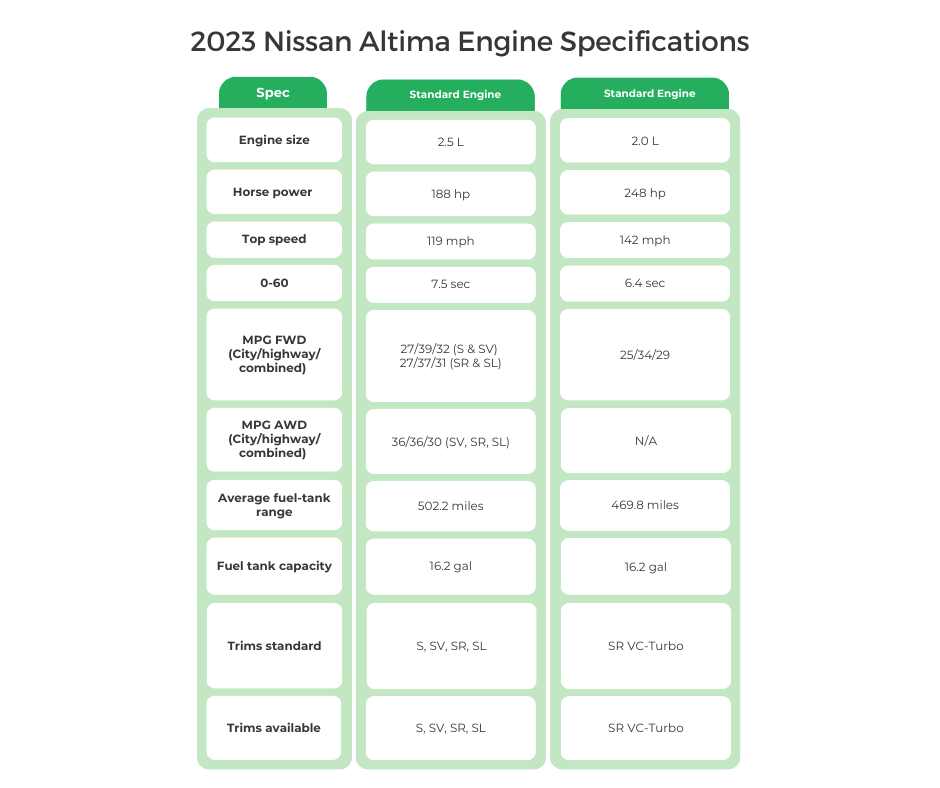
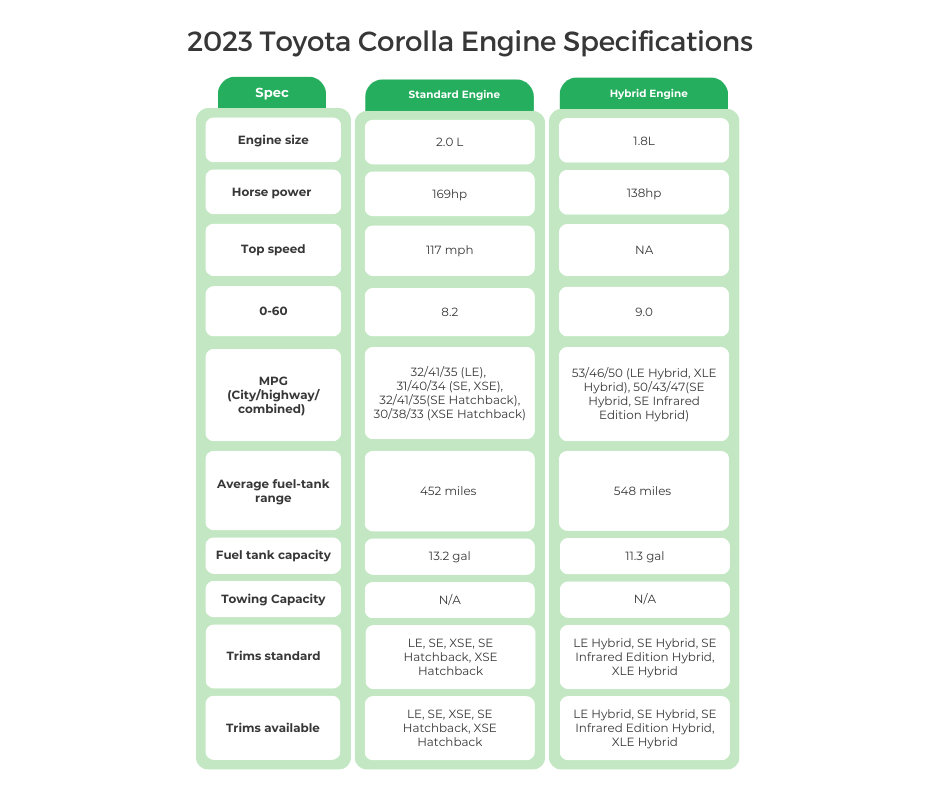
Transmission Options & Specifications:
Automakers like Nissan and Toyota love the continuously variable transmission (CVT) for being less expensive to produce while helping with fuel economy. That’s why price-sensitive cars like the Altima and the Corolla only come with CVTs, which self-shift like an automatic but use a belt system instead of separate gears. The Corolla Hybrid uses an eCVT.
See the “Tech Talk” section below the charts to learn about CVTs and eCVTs.
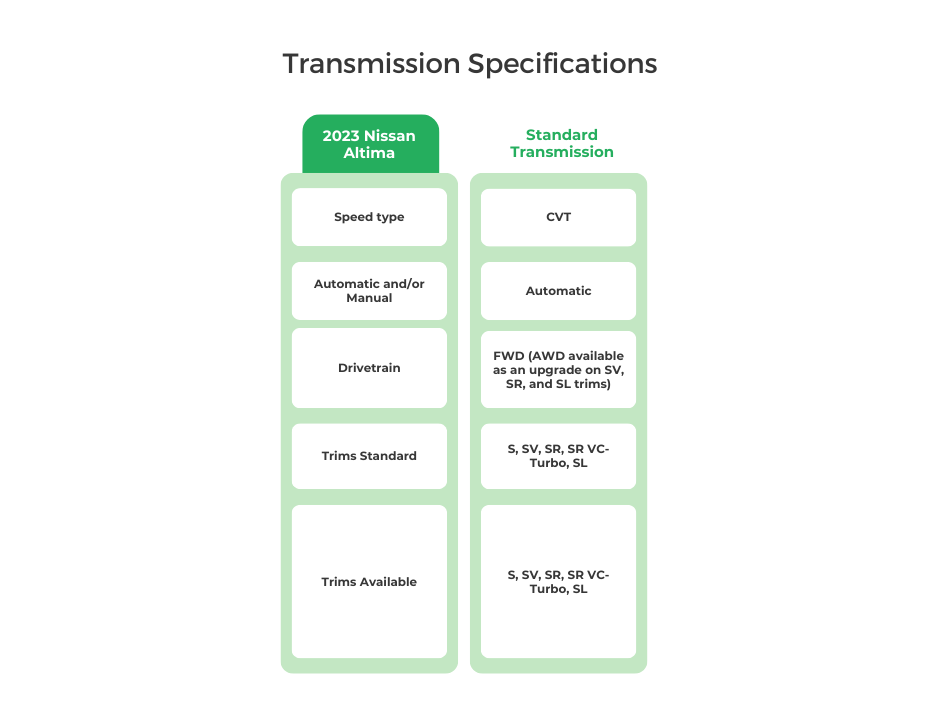
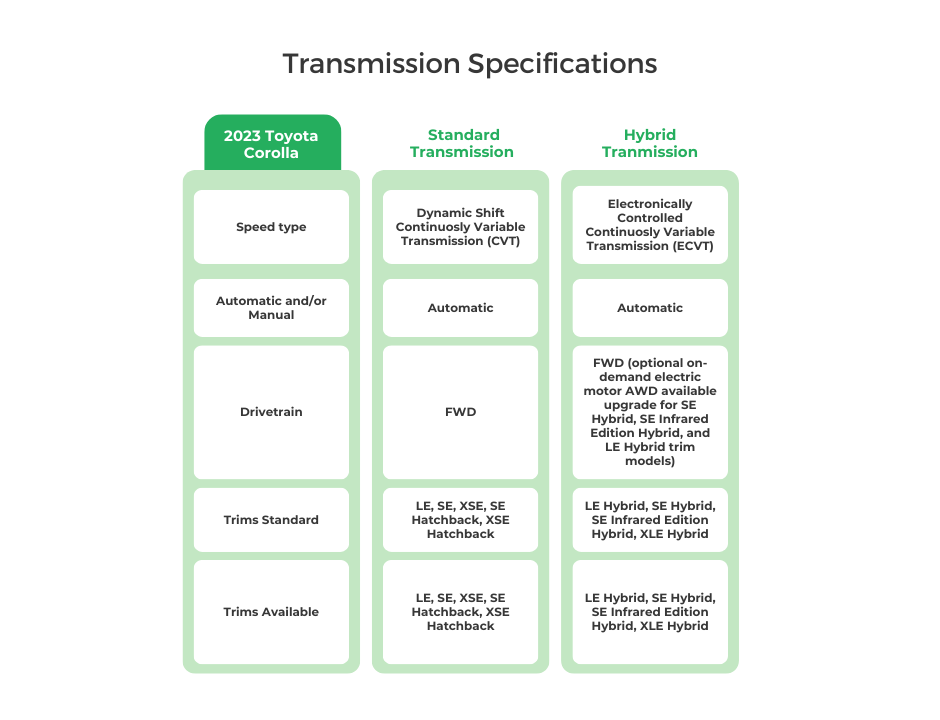
TECH TALK: CVTs
A continuously variable transmission (CVT) does not use gears like a typical automatic transmission. Instead, it has two pulleys connected by a belt. One pulley connects to the engine, and the other connects to the wheels. The belt transfers the power between the pulleys. This setup allows the pulleys to continuously change positions as needed. The CVT automatically adjusts the pulleys as required, providing smooth and efficient power delivery.
An electronic continuously variable transmission (eCVT) uses electronic controls and electric motors to vary gear ratios instead of a belt and pulley system. Unlike a regular CVT, an eCVT has no physical pulleys or belts—the gear ratio is adjusted seamlessly by controlling the speeds of electric motors and generators. This electronic control allows faster, smoother gear ratio changes compared to a traditional CVT. An eCVT also provides more flexibility, needing less space and having fewer moving parts.
Drivetrain:
While front-wheel drive (FWD) is nothing unusual in a modern automobile, all-wheel drive (AWD) is less common. Nonetheless, there are AWD options for the Altima and Corolla.
AWD keeps the Altima competitive with the segment sales leader (the Toyota Camry) and provides a leg up against the Honda Accord. Meanwhile, AWD keeps the Corolla relevant in an auto market dominated by compact and subcompact crossovers.
Otherwise, FWD is the standard drivetrain for the Altima and Corolla.
| 2023 Nissan Altima Wheel Drive | FWD | AWD | RWD |
| S | S | ||
| SV | S | U | |
| SR | S | U | |
| SR VC-Turbo | S | ||
| SL | S | U |
| 2023 Toyota Corolla Wheel Drive | FWD | AWD | RWD |
| LE | S | ||
| SE | S | ||
| XSE | S | ||
| Hybrid LE | S | E | |
| Hybrid SE | S | E | |
| Hybrid SE Infrared Edition | S | E | |
| Hybrid XLE | |||
| SE Hatchback | S | ||
| XSE Hatchback | S |
U = Available in upgrade
E = Electronic On-Demand AWD (Electric motor in Hybrid trims with on-demand AWD capabilities), available as an optional upgrade
Safety:
NHTSA Safety Ratings
Calling the Altima and Corolla family cars is an understatement. It’s an assumption backed by FIXD survey data. 45% of Altima owners and 43% of Corolla owners report using their vehicles for family transportation, more than any other car-related task. This activity is followed by “lots of driving” (commuting and long road trips) for 36% of Altima owners and 37% of Corolla owners.
All this time behind the wheel translates into a strong demand for a safe car. Nissan and Toyota recognize this and deliver the goods with the Altima and Corolla. Both vehicles received a perfect five-star overall safety rating in testing from the National Highway Traffic Safety Administration (NHTSA). Side crash tests were equally as notable.
Differences, although minor, emerge in other testing areas. The Altima received four stars (out of five) in the government’s frontal crash assessment, compared to five stars for the Corolla. That said, a four-star score is still commendable. Likewise, the Corolla ranked a four-star rating for its performance in rollover tests, while the Altima netted five stars.
As with some categories, neither the Altima nor the Corolla has a dominating result in safety testing. I suppose you could give a slight nod to the Corolla because of its perfect frontal crash testing; this type of accident is more likely to occur than a rollover.
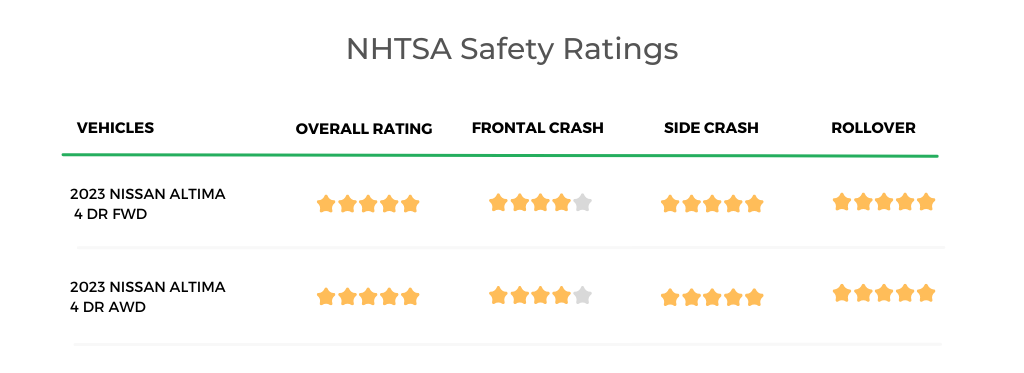
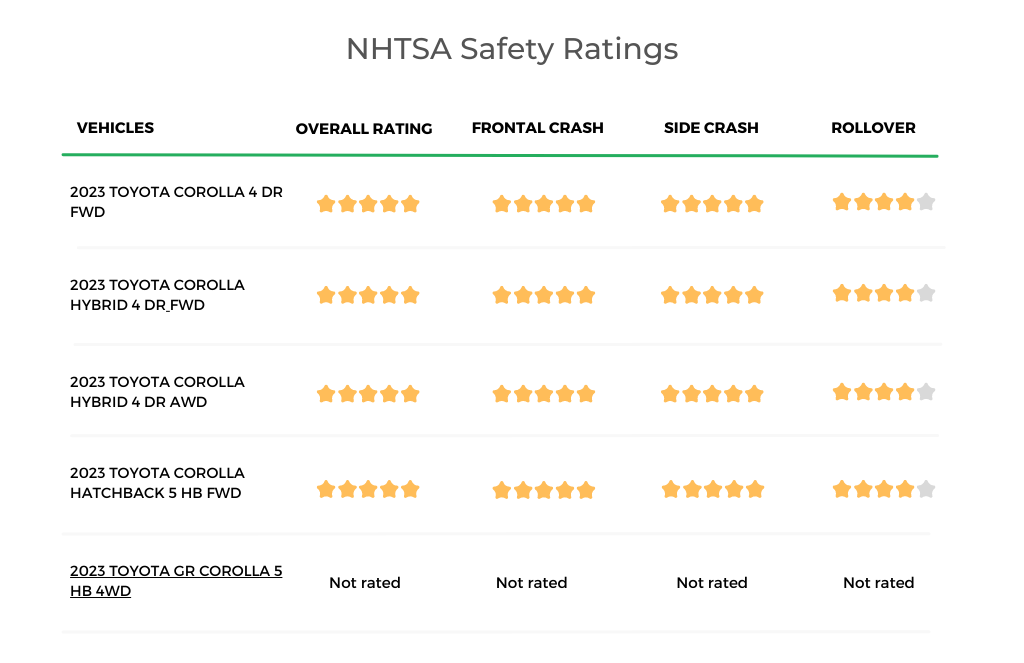
IIHS Awards:
The Insurance Institute for Highway Safety (IIHS) takes a somewhat different approach to safety testing. In particular, it focuses on its small frontal overlap crash test, which the organization feels represents a more real-world scenario (a single car running into a fixed object). IIHS also looks at side impact crashes, roof strength, headlight effectiveness, and advanced driver safety technologies (like automatic emergency braking).
While tested vehicles receive a Good, Acceptable, Marginal, or Poor grade, the true measure comes if a car gets a Top Safety Pick or Top Safety Pick+ designation. If “Good” is a “B” grade, Top Safety Pick notches things up to an “A-,” and the Top Safety Pick+ signifies an “A+.”
The cloudy safety picture becomes clearer as the 2023 Altima wins a Top Safety Pick+ award while the Corolla receives a still-commendable Top Safety Pick designation.
| IIHS Award | Tested Vehicle | ||
| 2023 Nissan Altima | Midsize Car/ 4-Door Sedan |
2022 TOP SAFETY PICK + | 2019 & 2023 Nissan Altima 2.5 S 4-door |
| 2022 Nissan Altima 2.5 SV 4-door |
|||
| 2023 Toyota Corolla | Small Car/ 4-Door Sedan |
2023 TOP SAFETY PICK | 2019 Toyota Corolla SE 4-door hatchback, 2022 Toyota Corolla LE 4-door sedan |
| Small Car/ 4-Door Hatchback |
2023 TOP SAFETY PICK | 2019 Toyota Corolla SE 4-door hatchback |
|
Airbags & Head Restraints:
Airbags and family cars go together like peanut butter and jelly; the Altima and Corolla have full complements of these life-saving devices. There are side curtain airbags to protect against side impacts or rollovers, and the front seat gets its share of coverage. At the same time, both cars get outboard airbags in the second row, a technology typically found in higher-end vehicles (Audi helped lead the charge). Further, both cars also get front knee airbags to better position occupants in a front-end accident. However, the Corolla only protects the driver with this technology, while the Altima has knee airbags for both front positions.
Neither the Altima nor the Corolla comes with overhead airbags. This newer technology replaces traditional front-row units (steering wheel and dashboard) with overhead devices. Active head restraints are usually found in specialty and high-end vehicles to minimize whiplash injuries. Mainstream cars like the Accord and Corolla aren’t usually equipped with this feature.
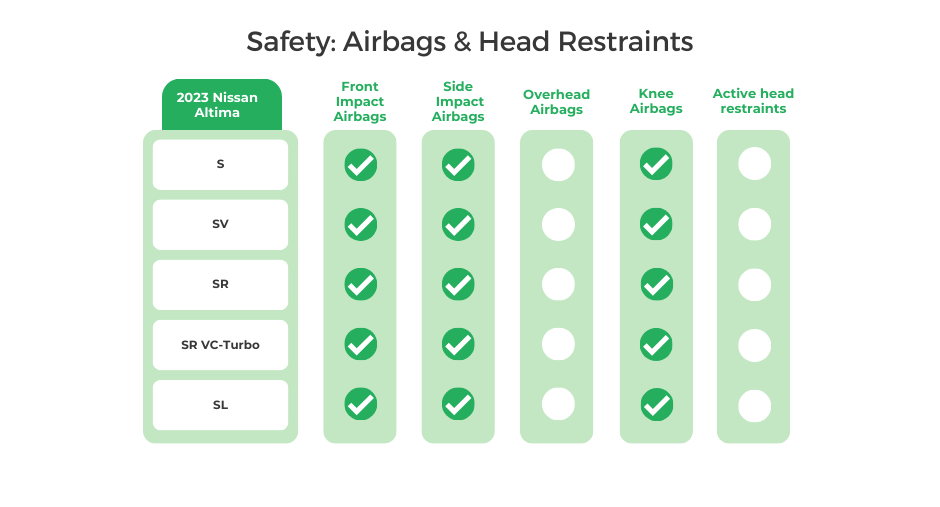
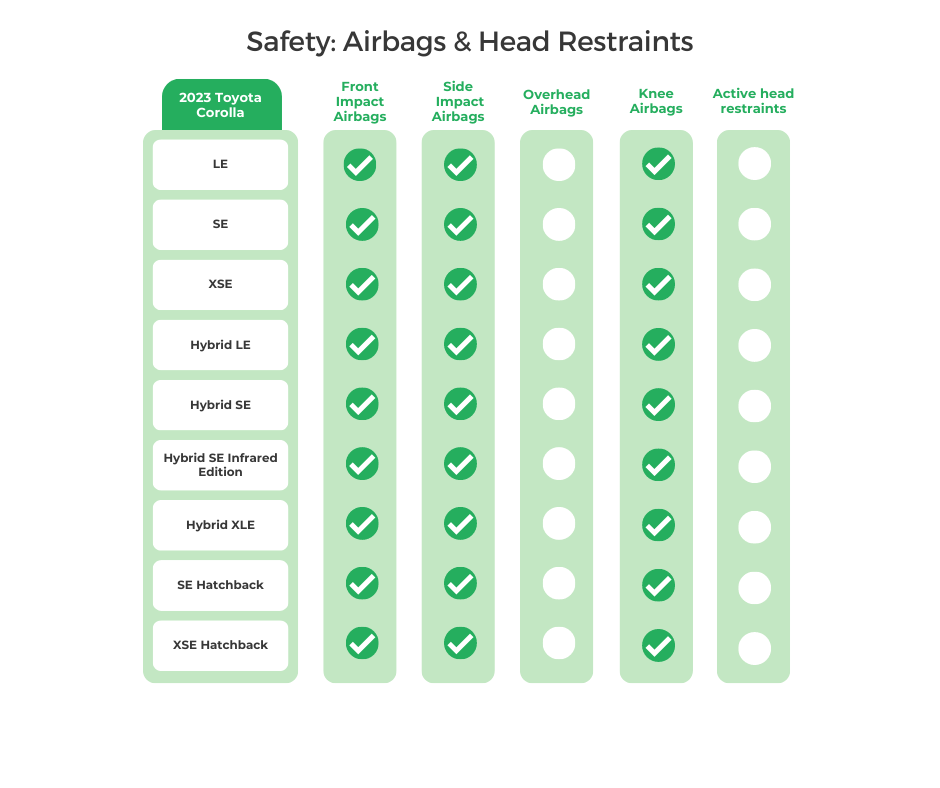
Semi-Autonomous Driving:
It’s important to mention that neither the Altima nor the Corolla comes with a hands-free driving system you’d find in a Tesla, Mercedes-Benz, or some other vehicles. The technology has yet to make its way to these mainstream vehicles. Instead, both cars have semi-autonomous driving features in the form of adaptive cruise control (ACC). Toyota calls its system Dynamic Radar Cruise Control, while Nissan uses the ProPilot Assist label. Notably, Nissan’s system is optional or standard on select trims, while ACC is standard on all 2023 Corollas.
ACC uses sensors like radar to monitor the speed and distance of vehicles ahead. It can then automatically adjust the car’s speed to maintain a safe following distance without the driver needing to manipulate the accelerator or brakes. The system helps reduce fatigue and makes highway driving more convenient and secure.
Lane-keeping assist for the Altima only comes with the ProPilot system, while the technology is standard with the Corolla but is only when ACC is in use.
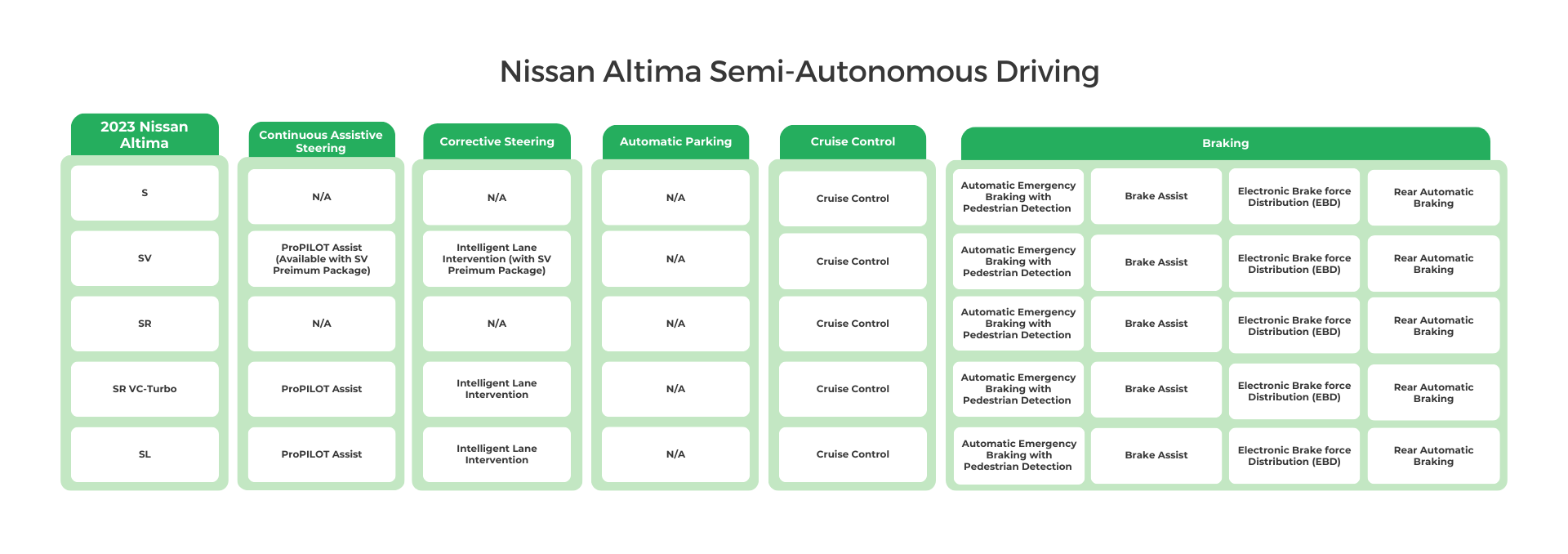
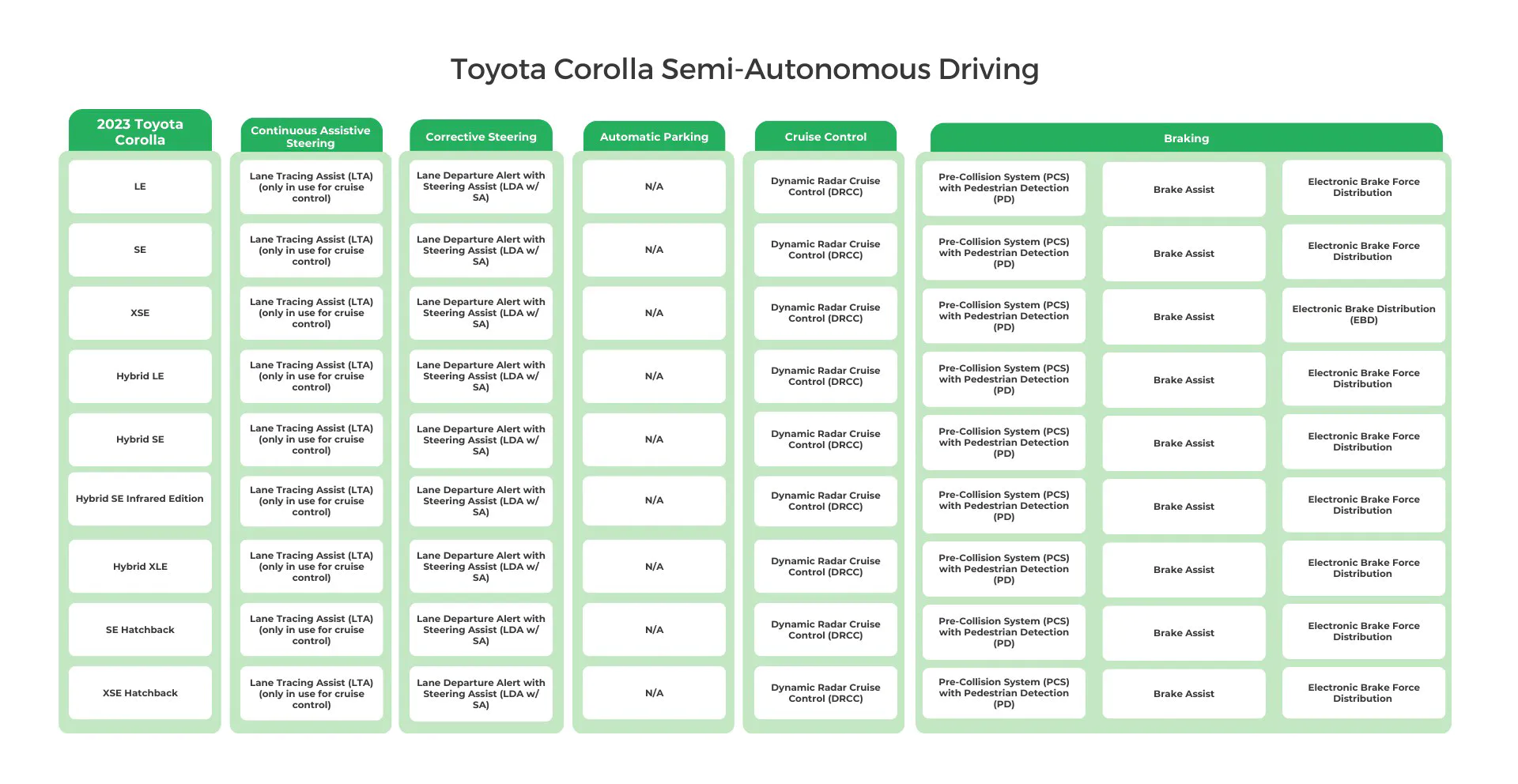
Driver Warning Systems & Telematics:
Advanced driver assistance systems (ADAS) are expected standard equipment these days, especially to buyers of family cars like the Altima and Corolla. Of course, auto marketers are never one to miss an opportunity to add a new phrase or label to their respective lexicons. So, the Altima comes with Nissan Safety Shield 360, and the Corolla has Toyota Safety Sense.
Both systems feature forward collision warning (FCW), automatic emergency braking (AEB) with pedestrian detection, and lane departure warning (LDW). Traffic sign recognition (TSR) is standard with all Corolla trims, while the feature is limited to Altimas with ProPIlot Assist.
I’ll give bonus points to Nissan for giving blind-spot monitoring (BSM) and rear cross-traffic alert (RCTA) to all Altima trims. It’s a significant safety feature that requires an option or a high-price trim with the Corolla.
If ADAS technology appears like alphabet soup, check out an effort from AAA, Consumer Reports, J.D. Power, and other groups working to standardize the terminology for these systems.


Road Visibility Features:
Given the mission of the Altima and Corolla (it’s that family car thing again), don’t expect high-end visibility technology (a head-up display or adaptive headlights, for example) on these cars. LED headlights and automatic high beams are about as fancy as it gets. Back-up cameras are required by law, although higher-trim Altimas have a surround-view monitor for easier low-speed maneuvering.
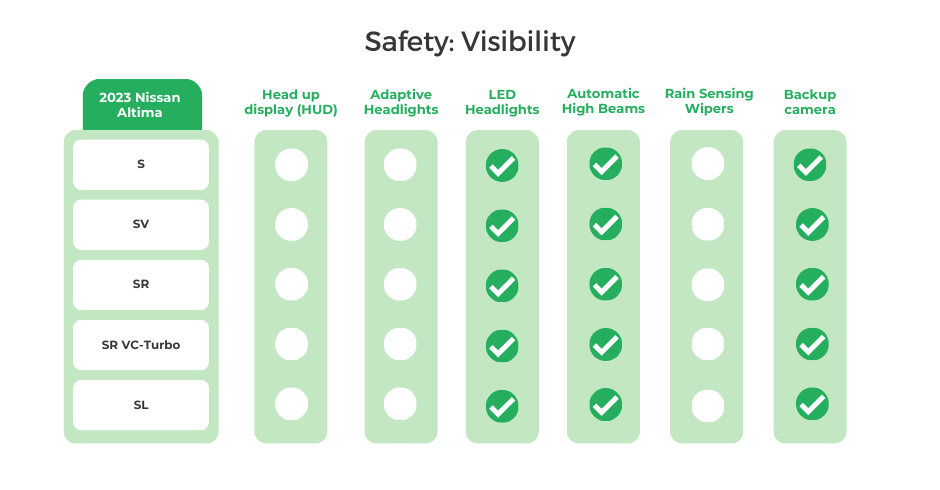
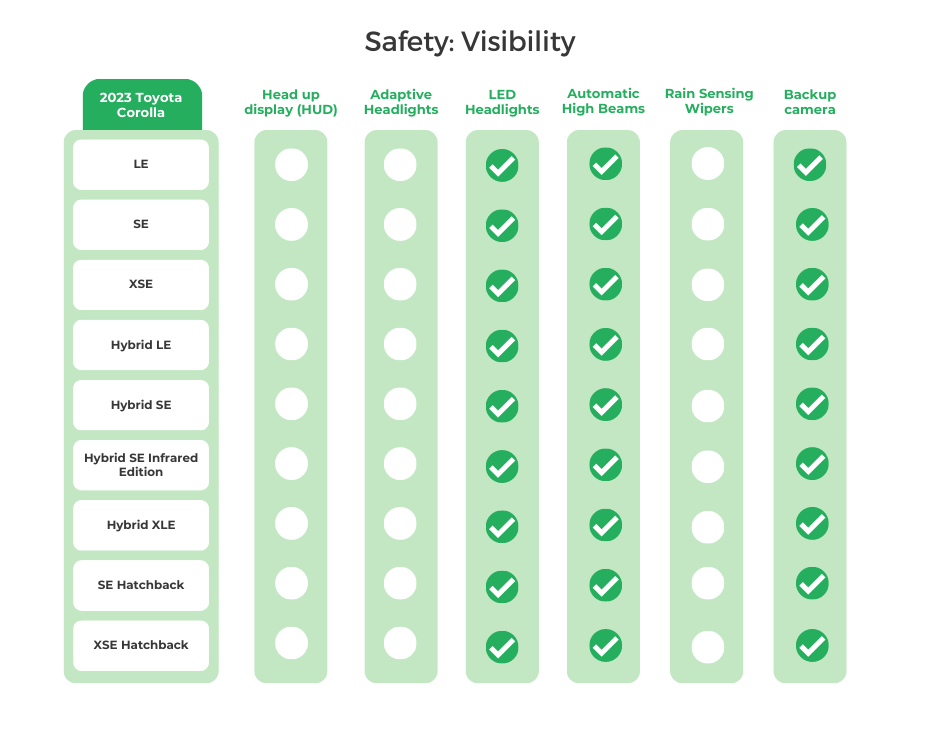
Interior:
Interior Features:
Dealing with cars regularly, it takes a lot to surprise me, but I was a bit dumbfounded to see that Nissan doesn’t offer Apple CarPlay and Android Auto in the base Altima S. This is especially puzzling because the archrival Toyota Camry has these features in its the entry-level LE trim. I suspect Nissan takes this approach to force buyers up to a more expensive trim, but how much can it cost to make the cheapest Altima more competitive with its Camry counterpart?
Equally important, because we’re comparing the Altima and Corolla, even the least expensive Corolla gets Apple CarPlay and Android Auto.
Separately, you’ll want to pay close attention to the Altima and Corolla trim levels if heated front seats are a must-have. This crosses out the base Altima and most Corolla trims from the shopping list. You’ll have to step up to a mid-tier Altima with an option pack or a higher-end edition to get heated front seats. Meanwhile, this feature is exclusive to the top-dog trims of the Corolla (the XSE and XLE Hybrid).
And speaking of heated seats, some automakers offer this feature through a subscription service. This hasn’t yet happened in the U.S., but in certain countries, BMW offered heated seats for a monthly fee. The advantage is you can shut off the service during warm months, but you’ll need to keep paying (or pay a one-time upfront fee) to activate the heated seats. Recently, BMW announced it was backing away from this practice. Moving forward, the automaker will only charge a subscription for software-based services (like upgraded navigation). Hardware-based features will be part of the vehicle’s initial purchase price.
One industry study shows mixed results for consumer acceptance of features on demand (FoD), with about one-fifth not even being aware of the concept.
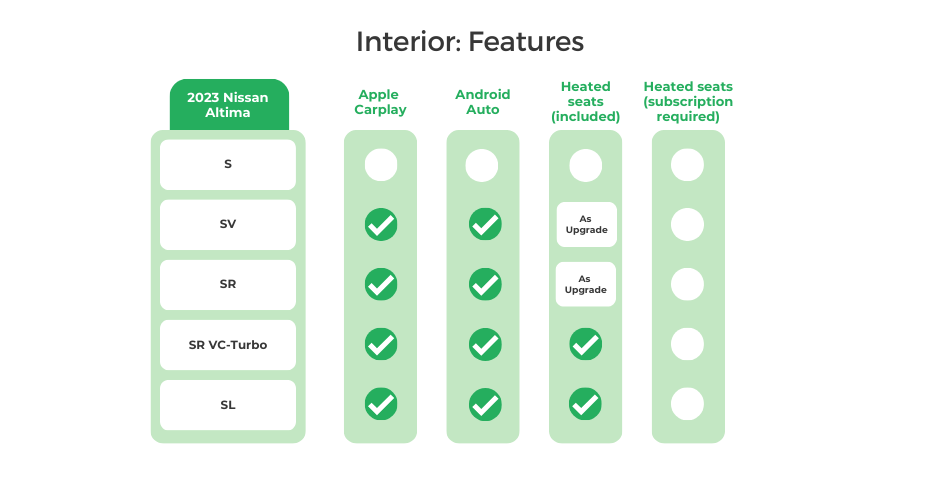
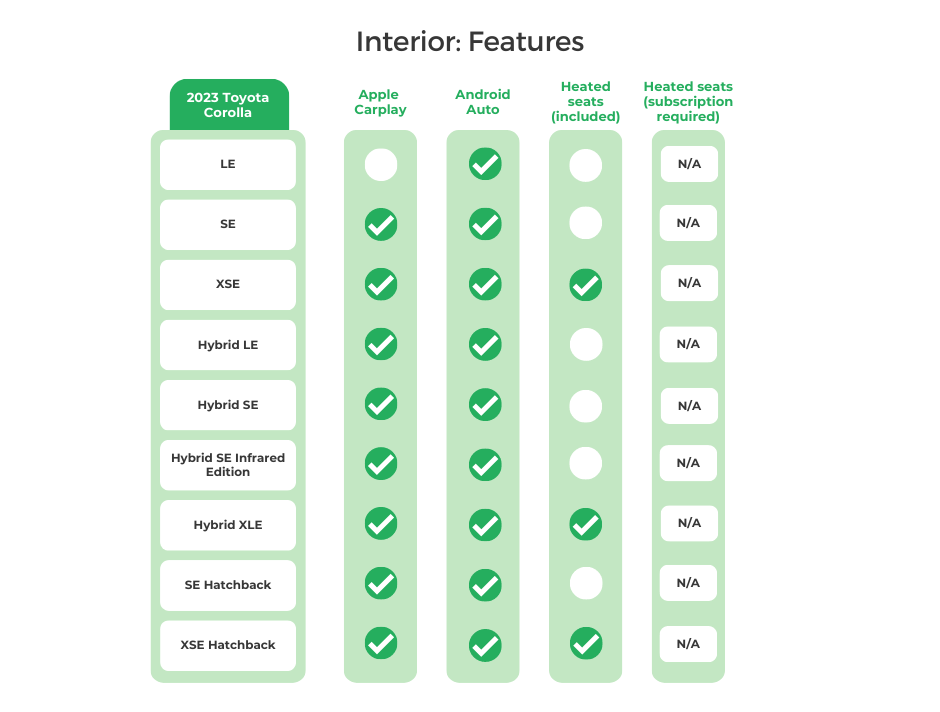
Interior Dimensions:
Now’s the time to see how the difference in passenger volume affects interior dimensions. Long-legged drivers (and front-seat passengers) will appreciate the Altima’s more expansive first row, with 43.8 inches of legroom, compared to 42 inches for the Corolla. But the rear legroom between the two sedans is evenly matched (35.2 inches for the Altima and 35.0 inches for the Corolla Sedan). On the other hand, 30 inches of rear legroom for the Corolla Hatchback is substantially less.
The Altima’s greater passenger volume also means substantially more front and rear shoulder and hip room. Interestingly, there’s not a significant difference in cargo space. The Altima’s 15.4 cubic-foot trunk may come in handy for road trips and over-the-top grocery shopping, but it’s not appreciably larger than the 13.1 cubic feet in the back of the Corolla Sedan. If cargo space is a priority, the 17.8 cubic feet behind the rear seat of the Corolla Hatchback comes out on top.
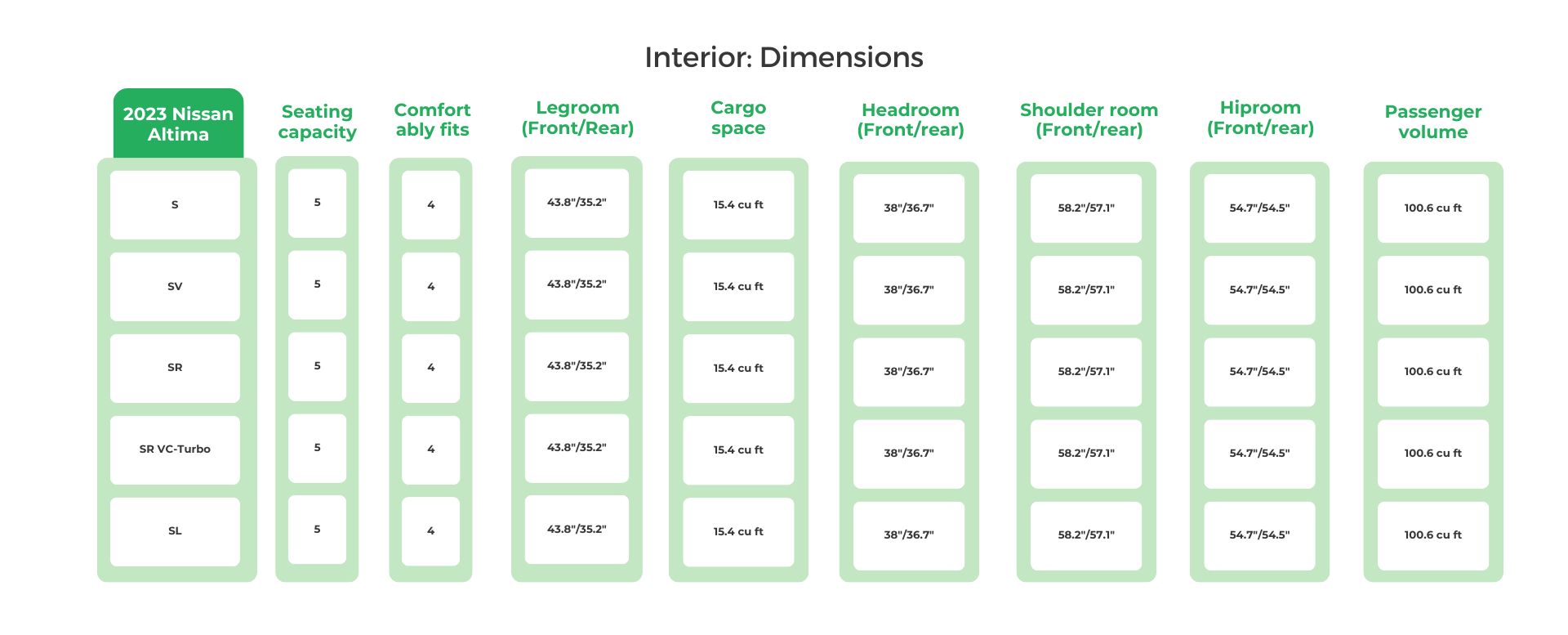
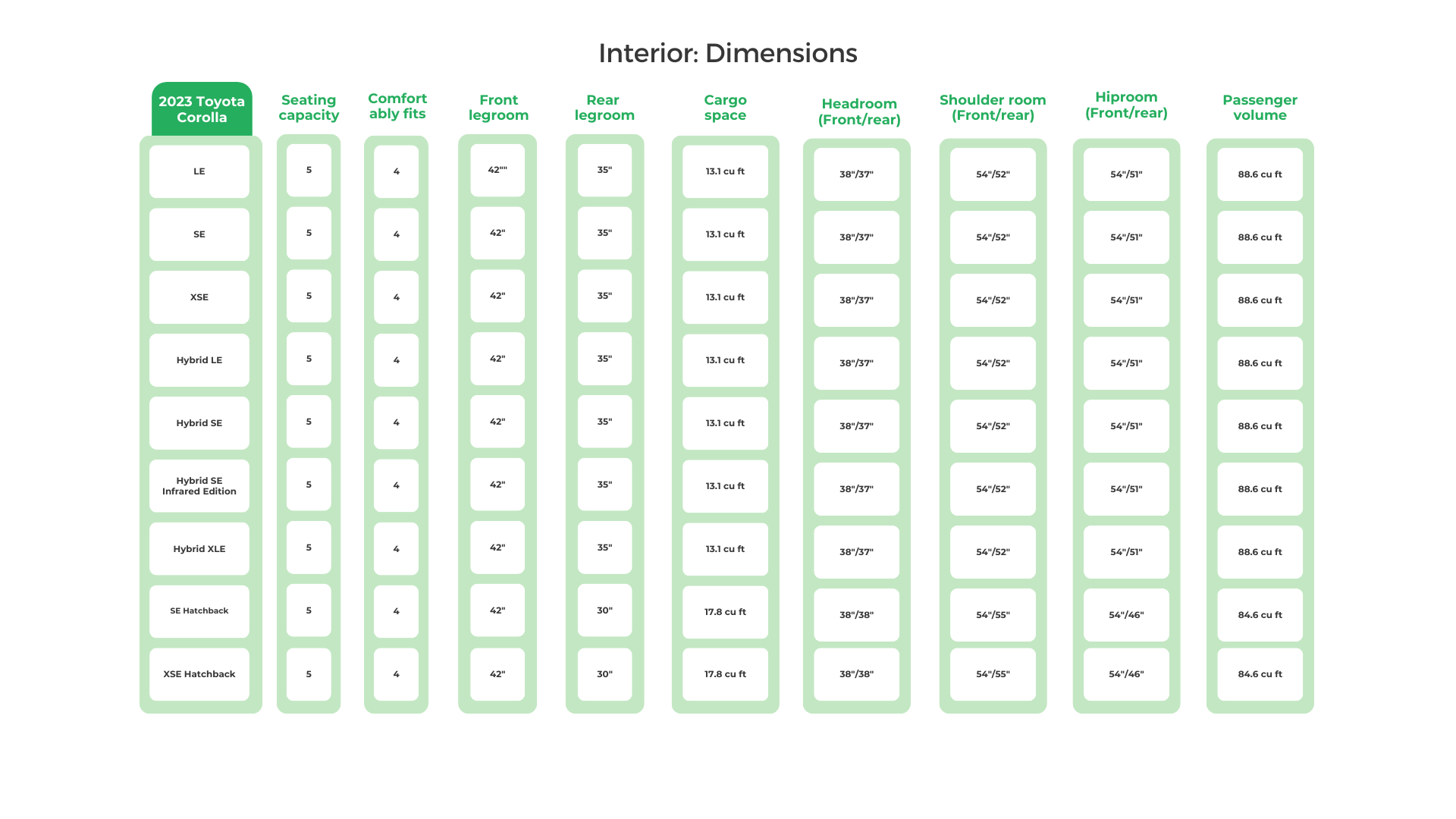
Exterior:
Exterior Features:
Wheels may also be an afterthought for many car buyers. But wheel size can impact ride quality. Larger rims can translate into better traction and cornering but may result in a bumpier ride. Bigger wheels also offer better aesthetics by filling out the wheel wells more completely. This is why the higher the trim, the larger the wheel. Different materials (steel or alloy) and finishes also help separate the wheels among the various trim levels.
If your vehicle color choices lean toward monotones (white, black, silver, and gray), picking an Altima or Corolla exterior won’t be a problem. You can also jazz things up with a muted shade of red or blue. However, a more vibrant option (bright red or orange) requires going with the Corolla Hatchback.
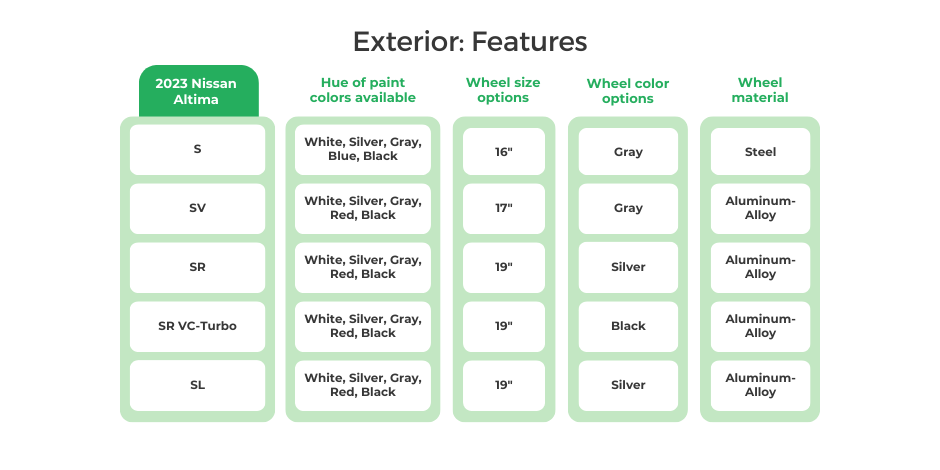
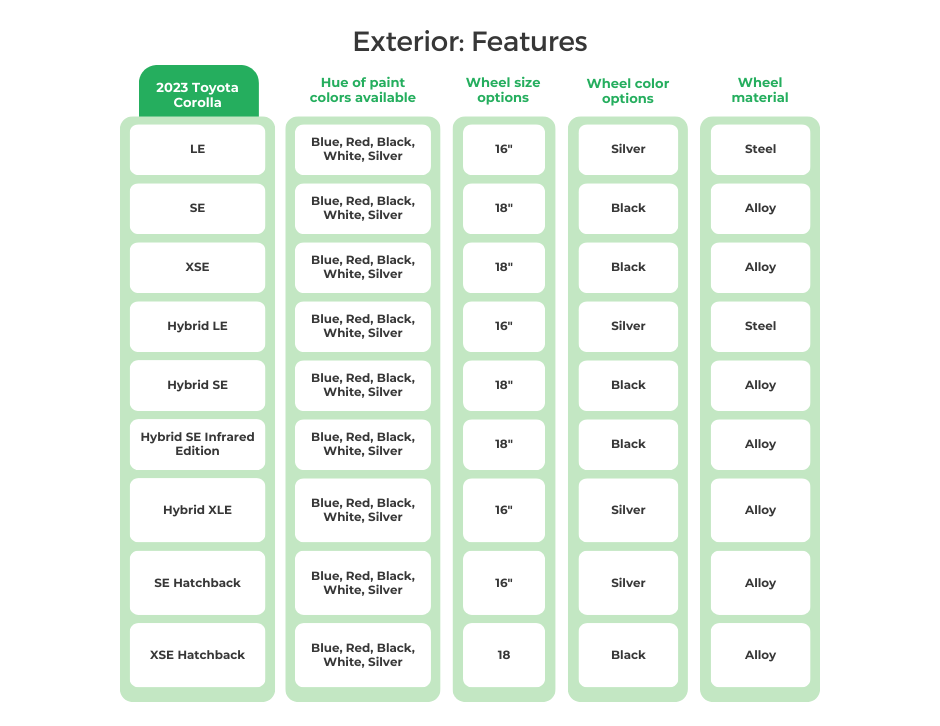
Exterior Dimensions:
The Altima’s larger interior means a bigger exterior. This Nissan is 10.9 inches longer than the Corolla Sedan (and 20.9 inches longer than the Corolla Hatchback). Further, the Altima’s more expansive shoulder and hip room come from 2.9 inches of greater width.
Most owners won’t be concerned with the Altima’s extra bulk. Only those dealing with urban environments and tight parking spaces may want to choose a Corolla for its more compact size (the hatchback in particular).
Another dimension that separates these two cars is the wheelbase. The Altima’s 111.2-inch measurement between the axles provides a smoother ride over highway expansion strips, speed bumps, and uneven streets. The shorter wheelbase of the Corolla (and especially the hatchback) leads to a choppy and less comfortable experience for the driver and passengers.
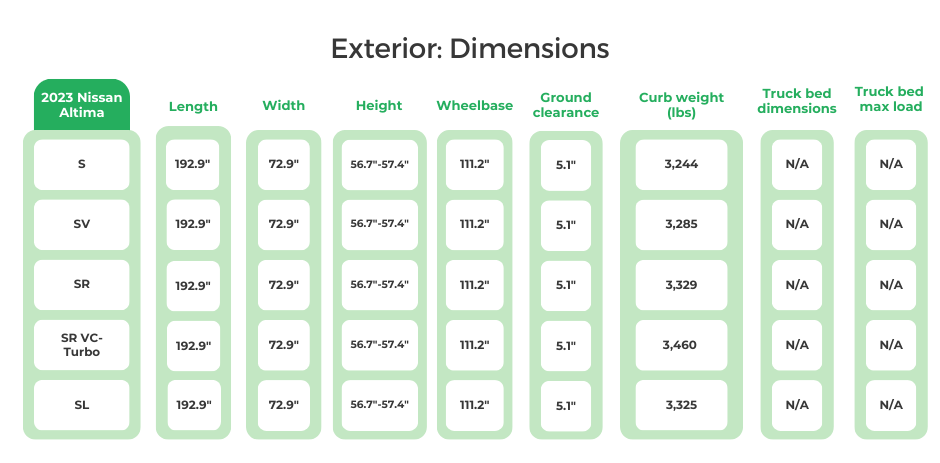
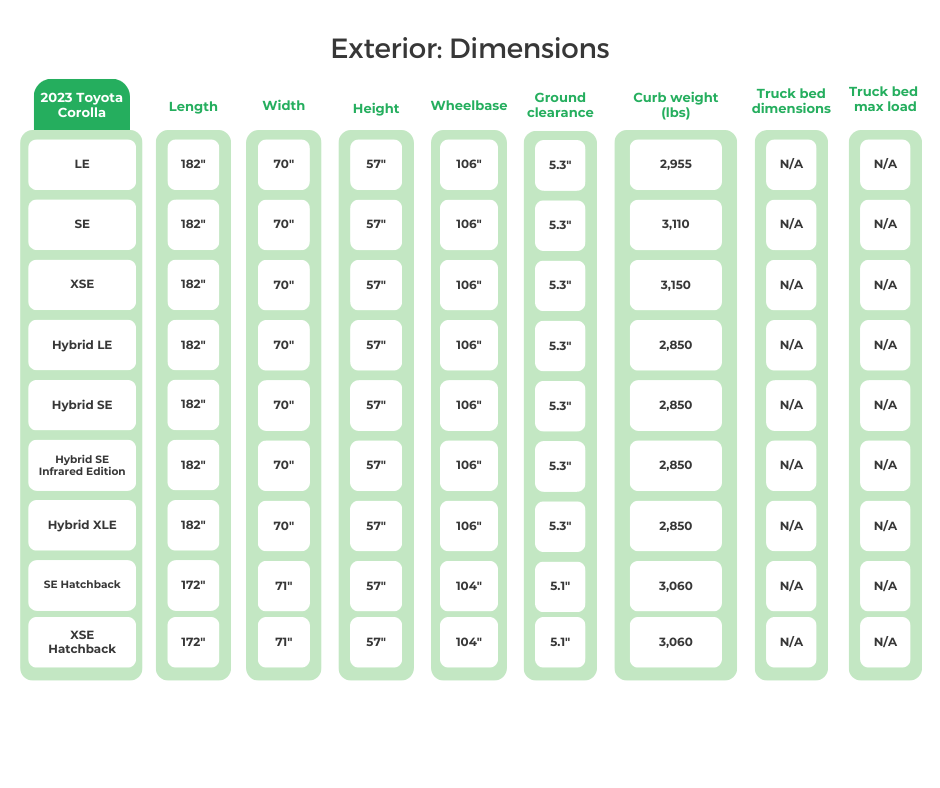
Warranty:
With Nissan and Toyota being head-on rivals (even if there are differences between the Altima and Corolla), is it any wonder that their warranty coverages are virtually identical? Both cars get a three-year or 36,000-mile bumper-to-bumper warranty and powertrain protection (for the engine, transmission, and drive axles) for five years or 60,000 miles.
The only thing separating the warranties is that roadside assistance for the Altima lasts the duration of the bumper-to-bumper warranty, while the Corolla gets this help for 24 months or 25,000 miles. Also, Nissan doesn’t impose a mileage limit for covering the air conditioning refrigerant during the first year of ownership.
| 2023 Nissan Altima Factory Warranty Coverage: |
2023 Toyota Corolla Factory Warranty Coverage: |
|
| Basic warranty: | 36 months/36,000 miles | 36 months/36,000 miles |
| Powertrain warranty: | 60 months/60,000 miles | 60 months/60,000 miles |
| Corrosion perforation warranty: | 60 months/unlimited miles | 60 months/unlimited miles |
| Air conditioning warranty*: | 12 months/unlimited miles | 12 months/12,000 miles |
| Hybrid Battery warranty: | N/A |
120 months/150,000 miles (Hybrid Battery) |
| Emissions warranty: | Federal: 36 month/36,000 miles (defect), 24 months/24,000 miles (performance) California: 36 months/50,000 miles (defect), 36 months/50,000 miles (performance) |
Federal: 36 month/36,000 miles (defect), 24 months/24,000 miles (performance) California: 36 months/50,000 miles (performance) |
| Roadside assistance coverage: | 36 months/36,000 miles | 24 months/25,000 miles |
| Total unique recalls: | 0 | 1 |
Driver Experience | A Summary of The Top Nissan Altima Vs. Toyota Corolla Reddit Posts:
Reddit has no shortage of conversations about the Nissan Altima and Toyota Corolla. Here’s a look at highlights of some of the discussions from r/whatcarshouldIbuy. Comments on several posts indicate a clear tilt toward Toyota when comparing the Altima and Corolla head-to-head.
One Redditor stated, “The Altima will be cheaper, but the Corolla will be more reliable and have better resale values.” This sentiment was echoed by several others, with reliability being the key advantage given to the Corolla over the Altima. Another commented, “Toyota has proven reliability while Nissan has really declined in recent years.”
Specifically, there is concern over the dependability of recent Nissan models, including the Altima. One commenter noted they would “go with a Corolla over an Altima. The Corolla is reliable basic transportation while the Altima doesn’t have a great reputation for reliability these days.” Another advised choosing the Corolla because “the Altima has had serious issues with their CVT transmissions.”
Resale value was another area where Redditors favored the Corolla. The Corolla earned praise for its better-projected resale value compared to the Altima. As one user put it, they recommend the Corolla because “the resale values on Toyota vehicles vastly outpaces Nissan.” Even accounting for any potential discounted pricing on the Nissan, the Toyota is seen as the better long-term value.
Who Should Buy These Cars: The Legacy of The Nissan Altima and Toyota Corolla
The Nissan Altima and Toyota Corolla check many boxes for family car shoppers: strong safety scores, good fuel economy, and reasonable prices. These characteristics are well suited for commuting and long-distance driving, which FIXD owner surveys report are the most frequent uses of the vehicles.
Buyers should also realize the longevity of the Altima and Corolla usually reaches 150,000-2000,000 miles.
| Frequent Use Categories: | Nissan Altima | How Useful? (Out of 5 Stars) |
Toyota Corolla | How Useful? (Out of 5 Stars) |
| Family Vehicle | * * * * * | * * * * |
| Lots of Driving (travel/long commute) | * * * * * | * * * * * |
| Hauling/Towing | * | * |
| Office on Wheels | * | * |
| Sport/Fast Driving | * | * |
| Luxurious Driving | * | * |
| Outdoor/Off-Road | * | * |
Best & Worst Years | Nissan Altima Vs. Toyota Corolla | 2001-2024

The earlier Reddit comments highlight concerns about the Altima’s reliability. This comes to light in the graphic showing that older model years (2001-2009) are the ones to avoid. Of course, Corollas from this period aren’t perfect either. But at least there are a few more options (2004, 2007-2008) that get a green light.
However, things turned a corner for both cars, starting with the 2010 model year. There are numerous options, except for the 2011 Altima and 2020 Corolla.
I’ll also call attention to the undecided years (yellow) only because there isn’t enough information to give these editions a thumbs up or down.
Important Features Timeline | Nissan Altima Vs. Toyota Corolla
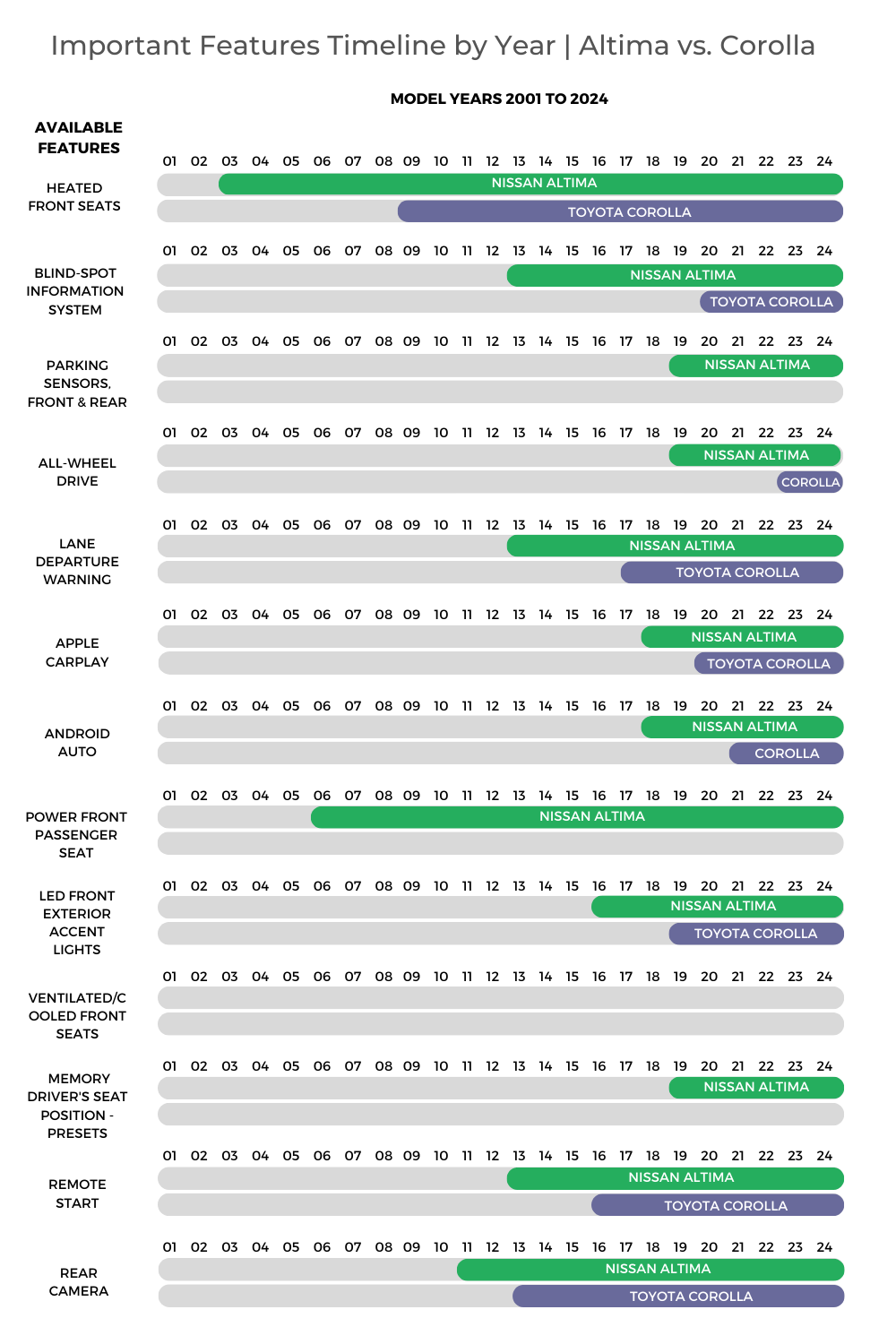
The Altima gets the newest features sooner because it has a higher position in Nissan’s lineup. Automakers introduce new technologies and equipment first to more expensive models. Over time, many of these goodies reach lower-priced models. The graphic shows this is exactly the case in this Altima versus Corolla comparison.
For instance, heated front seats came to the Altima in 2003, but the Corolla didn’t get this feature until 2009. The same goes for safety technology. The Altima got the blind-spot warning feature in 2013, but Toyota took seven years to add this driver-assist system to the Corolla. Yet, some tech (a driver’s memory system and parking sensors, to name a few) has yet to reach the Corolla.
Maintenance Costs (Year-by-Year Average) | Nissan Altima Vs. Toyota Corolla
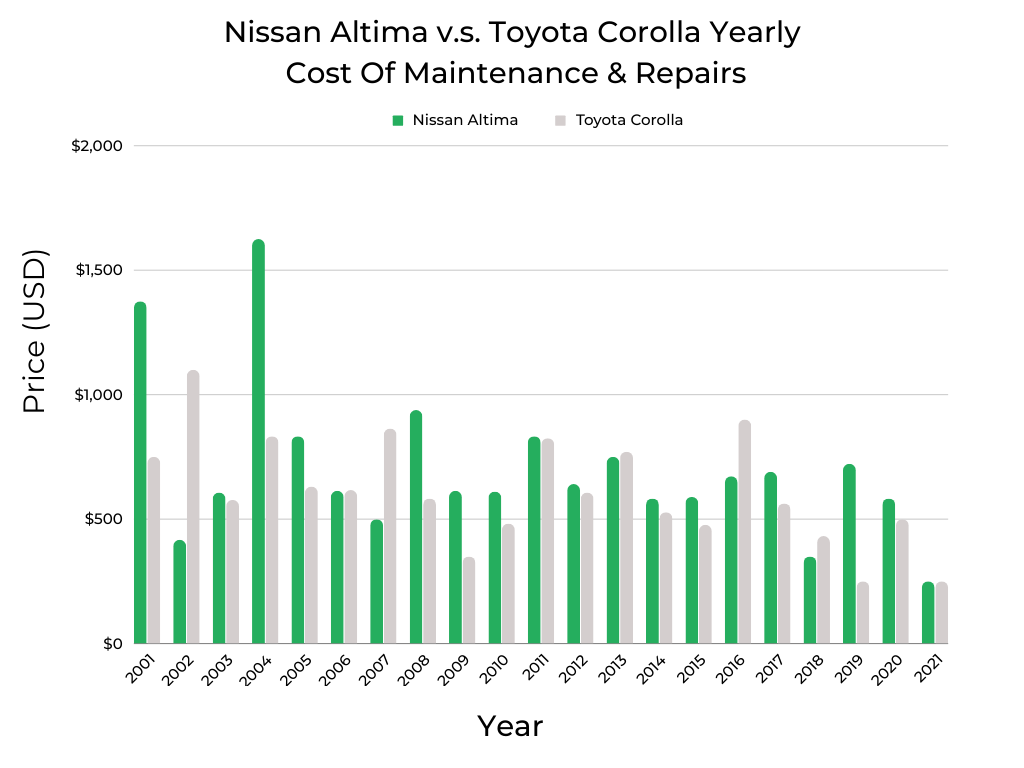
Annual maintenance and repairs for Altima and Corolla appear reasonable when looking at averages. FIXD survey data reveals that the typical Altima owner spent $705 in 2022 for upkeep on their car. The figure is $614 for a Corolla.
However, looking at individual model years uncovers that some Altimas and Corollas are more expensive to own than others. The 2001, 2004, and 2008 Altimas had maintenance and repair expenses at least 20% above average. What I found stunning was the number of Corolla model years that exceeded the $705 average by 20% or more. Editions from 2001, 2002, 2004, 2007, 2011, 2013, and 2016 all fall in this category. That’s 38% of Corolla model years from 2001-2021. The Corolla’s reputation for reliability isn’t so bulletproof.
Review the best and worst years of the Nissan Altima and Toyota Corolla to learn more about these vehicles’ maintenance and repair costs.
Safety Rating Comparison | Nissan Altima Vs. Toyota Corolla
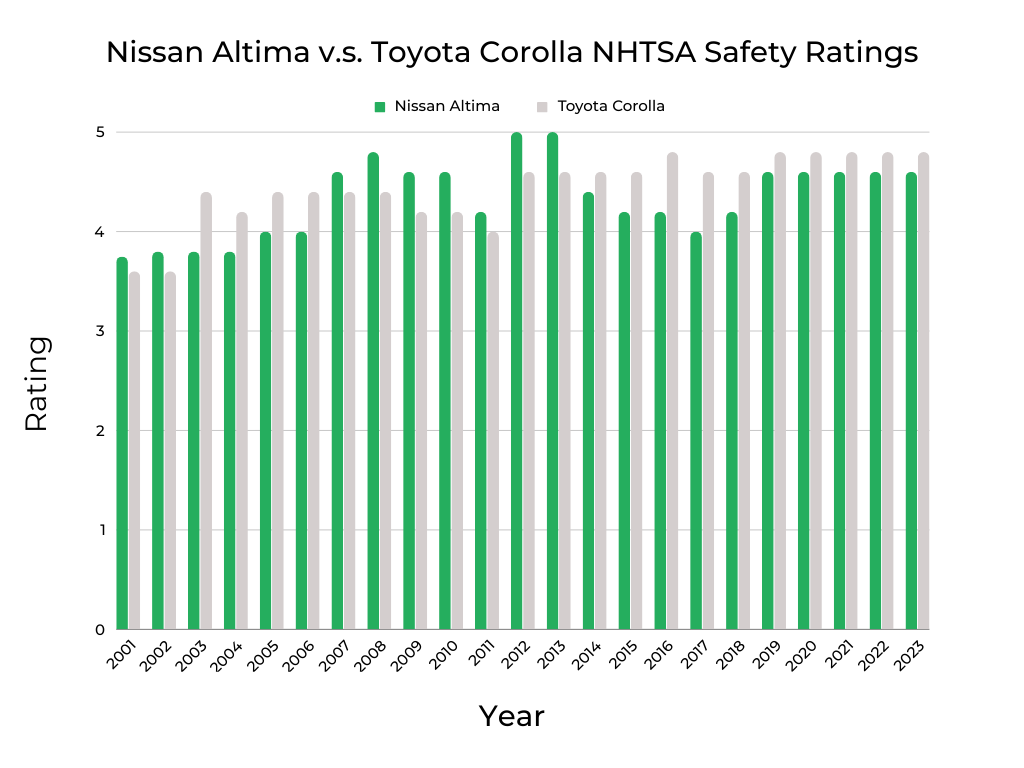
As mentioned, safety matters for family car buyers, but the reality is that few cars consistently achieve perfect (5 out of 5) crash test scores across multiple years. For example, between these two cars from the 21st century, only the 2012 and 2013 Altima achieved top scores. That said, focusing on ratings of at least 4 (out of 5) is the way to go. This is easy to do with the Altima or the Corolla, as most model years meet this benchmark. Older examples do rank below a 4, but these models are among the worst years, so shoppers should look elsewhere. There’s also a drop for the 2011 model year, which reflects more rigorous testing implemented by NHTSA. Scores for the Altima and Corolla bounced back the following year.
More details about crash test safety scores are covered in articles about the Nissan Altima and Toyota Corolla.
Fuel Efficiency Comparison | Nissan Altima Vs. Toyota Corolla
Although the Nissan Altima provides respectable fuel economy, it falls short against the smaller and less powerful Toyota Corolla. With an average of 25 mpg or better, newer Altimas (2013 and later) come closer to the Corolla, but older examples hover closer to 20 MPG. Meanwhile, the Corolla’s fuel economy reaches closer to or exceeds 30 MPG. Shoppers who prioritize saving gas will want to keep this in mind.
All bets are off when it comes to hybrid fuel economy. The Corolla Hybrid’s fuel-sipping (about 50 mpg) is admirable and without an Altima equivalent. Nissan introduced an Altima Hybrid (using technology licensed from Toyota) from 2008 to 2011, but it never was successful. According to greencarreports.com, the company sold only 35,000 examples over four years.
Methodology
- Compare two vehicles, Nissan Altima and Toyota Corolla, and provide a comprehensive analysis.
- Gather relevant information and data on both vehicles from reliable sources, such as manufacturer specifications, expert reviews, customer feedback, industry reports, and data sources like manufacturer websites, FIXD App, Kelley Blue Book, FuelEconomy.gov, and NHTSA.
- Collect data on various aspects, including performance, safety features, fuel efficiency, maintenance costs, reliability, owner satisfaction, and market value.
- Identify the key criteria that will be used to evaluate and compare the two vehicles.
- Ensure the criteria cover both objective factors (such as performance metrics, safety ratings, and fuel efficiency) and subjective factors (such as owner satisfaction, comfort, and features).
- Assess the performance of both vehicles based on factors such as acceleration, handling, braking, and overall driving experience.
- Compare engine options, horsepower, torque, transmission options, and any unique performance features.
- Examine the safety features and ratings of both vehicles.
- Evaluate crash test ratings, advanced driver assistance systems (ADAS), active and passive safety features, and any notable recalls or known issues related to safety.
- Consider both NHTSA safety ratings and IIHS awards for a comprehensive safety assessment.
- Analyze the fuel economy of both vehicles based on EPA mileage estimates.
- Compare their MPG ratings, average full-tank range, and any significant differences in fuel efficiency.
- Assess the average annual maintenance and repair costs for both vehicles.
- Consider data from surveyed owners and other reliable sources, such as FIXD App owner surveys, to determine the overall cost of ownership over time.
- Evaluate the reliability of both vehicles based on owner reports, FIXD App data, and any known issues or recalls.
- Consider factors such as engine reliability, common problems by model year, long-term durability, and owner reliability scores gathered from surveys.
- Consider owner satisfaction by gathering information from forums, online communities (Reddit: r/whatcarshouldIbuy), customer reviews, and owner reliability scores.
- Summarize key factors that owners appreciate and any common complaints or drawbacks mentioned by owners.
- Compare the features and technologies offered by both vehicles.
- Highlight any notable differences in terms of infotainment systems, connectivity options, driver assistance features, interior quality, and available upgrades.
- Assess the market value and depreciation of both vehicles.
- Compare average prices, resale value, and how the vehicles hold their value over time.
- Consider average private-seller valuations from Kelley Blue Book (KBB) for a comprehensive assessment.
- Summarize the findings of the comparison, highlighting the positives and negatives of each vehicle.
- Provide a fair and balanced recommendation based on the comparison, considering factors such as budget, personal preferences, specific needs of the buyer, and the comprehensive analysis conducted.
Sources:
- KBB Values: Average private-seller valuations as supplied by Kelley Blue Book (KBB), based on a Nissan Altima and Toyota Corolla with typical mileage for that respective model year.
- Fuel Economy: Mileage-per-gallon estimates according to the EPA MPG on Fueleconomy.gov.
- Annual Maintenance/Repairs: Upkeep expenses as reported by surveyed Nissan Altima and Toyota Corolla owners.
- Safety Ratings: Crash test data collected and reported by NHTSA. We average all ratings for each year to come up with a simplified, average safety score. This makes it easier to look at on a graph. We also collected IIHS Awards for this article.
- Vehicle Features: Most or all information gathered on vehicle features was from the manufacturer’s website, in this case, nissanusa.com and toyota.com.

Dave Goldberg is an automotive journalist and lifelong car fanatic. He writes for numerous enthusiast and business outlets and is an ongoing contributor to HotCars.com, one of the most popular car culture websites. When he’s not writing or driving, Dave is either under a hood or asleep. His credentials include a BA in Journalism from The George Washington University.

